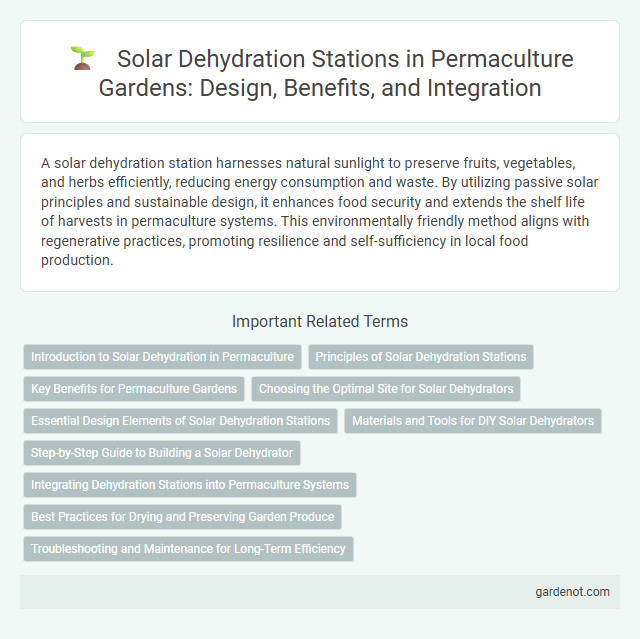A solar dehydration station harnesses natural sunlight to preserve fruits, vegetables, and herbs efficiently, reducing energy consumption and waste. By utilizing passive solar principles and sustainable design, it enhances food security and extends the shelf life of harvests in permaculture systems. This environmentally friendly method aligns with regenerative practices, promoting resilience and self-sufficiency in local food production.
Introduction to Solar Dehydration in Permaculture
Solar dehydration in permaculture harnesses natural solar energy to effectively preserve fruits, vegetables, and herbs without relying on electricity. This sustainable method reduces food waste, extends shelf life, and maintains nutritional value by using low-temperature drying that aligns with permaculture principles of energy efficiency and ecological balance. Solar dehydrators enhance food security by enabling growers to store surplus harvests and promote self-sufficiency within resilient permaculture systems.
Principles of Solar Dehydration Stations
Solar dehydration stations utilize the principle of harnessing renewable solar energy to efficiently remove moisture from food, preserving nutrients and extending shelf life without relying on electricity. These stations optimize airflow and temperature control through passive solar design, ensuring consistent drying conditions that prevent microbial growth. Integrating local materials and sustainable construction methods reduces environmental impact while supporting community resilience and food security.
Key Benefits for Permaculture Gardens
Solar dehydration stations significantly reduce food waste by efficiently drying surplus fruits, vegetables, and herbs in permaculture gardens, preserving nutrients and extending shelf life. They utilize renewable solar energy, lowering carbon footprints and operational costs while maintaining organic integrity. This sustainable method supports year-round food availability and enhances garden self-sufficiency.
Choosing the Optimal Site for Solar Dehydrators
Selecting the optimal site for solar dehydrators requires prioritizing locations with maximum sun exposure, typically south-facing areas free from shade caused by trees or buildings to ensure consistent drying efficiency. The site should have good ventilation to facilitate airflow, which helps prevent moisture buildup and reduces drying time for fruits, vegetables, and herbs. Proximity to the harvest area minimizes transportation time and preserves product freshness while ensuring the station is elevated or well-drained to avoid water accumulation during rainy seasons.
Essential Design Elements of Solar Dehydration Stations
Essential design elements of solar dehydration stations include transparent glazing materials to maximize solar radiation absorption and an insulated drying chamber to retain heat efficiently. Proper airflow management, typically through adjustable vents and solar-powered fans, ensures uniform moisture removal and prevents mold growth. The integration of UV-resistant materials enhances durability and maintains optimal drying conditions over prolonged exposure to sunlight.
Materials and Tools for DIY Solar Dehydrators
Essential materials for a DIY solar dehydration station include transparent UV-resistant acrylic sheets, untreated wood frames, and fine mesh screens to ensure optimal airflow and protection from insects. Tools such as a cordless drill, jigsaw, measuring tape, and clamps facilitate precise assembly and customization of the dehydrator structure. Incorporating adjustable vents and reflective insulation materials enhances solar heat absorption and moisture control for efficient food drying.
Step-by-Step Guide to Building a Solar Dehydrator
A solar dehydration station efficiently uses solar energy to remove moisture from fruits, vegetables, and herbs, preserving nutrients and extending shelf life. Start by selecting durable, UV-resistant materials and constructing a wooden frame with transparent polycarbonate panels to maximize sunlight absorption and heat retention. Incorporate adjustable vents for airflow control, a dark interior surface for heat absorption, and stackable trays to ensure even drying and optimal moisture removal.
Integrating Dehydration Stations into Permaculture Systems
Integrating solar dehydration stations into permaculture systems enhances sustainable food preservation by utilizing renewable solar energy for drying fruits, vegetables, and herbs, reducing waste and extending shelf life. These stations complement permaculture principles by recycling heat and moisture within the ecosystem, promoting energy efficiency and minimizing carbon footprint. Strategically placed within food forests or garden zones, solar dehydrators support resilience and food security by enabling off-season consumption of surplus harvests.
Best Practices for Drying and Preserving Garden Produce
A solar dehydration station maximizes natural sunlight to efficiently dry fruits, vegetables, and herbs, preserving their nutrients and extending shelf life. Best practices include slicing produce uniformly, ensuring ample airflow with mesh trays, and monitoring moisture levels to prevent mold growth. Maintaining a consistent temperature around 120degF (49degC) optimizes dehydration time while safeguarding the quality of garden harvests.
Troubleshooting and Maintenance for Long-Term Efficiency
Proper troubleshooting and maintenance of a solar dehydration station ensure optimal performance and prolonged equipment lifespan. Regular inspection of solar panels for dust accumulation and damage, timely replacement of faulty sensors, and cleaning of drying trays prevent efficiency loss. Monitoring system temperature and airflow helps identify operational issues early, maintaining consistent dehydration quality and energy effectiveness.
Solar dehydration station Infographic

 gardenot.com
gardenot.com